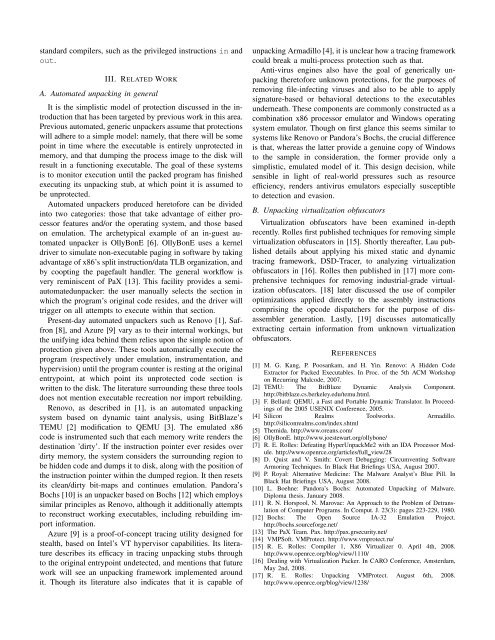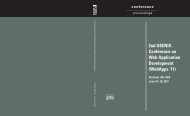Unpacking Virtualization Obfuscators - USENIX
Unpacking Virtualization Obfuscators - USENIX
Unpacking Virtualization Obfuscators - USENIX
Create successful ePaper yourself
Turn your PDF publications into a flip-book with our unique Google optimized e-Paper software.
standard compilers, such as the privileged instructions in and<br />
out.<br />
III. RELATED WORK<br />
A. Automated unpacking in general<br />
It is the simplistic model of protection discussed in the introduction<br />
that has been targeted by previous work in this area.<br />
Previous automated, generic unpackers assume that protections<br />
will adhere to a simple model: namely, that there will be some<br />
point in time where the executable is entirely unprotected in<br />
memory, and that dumping the process image to the disk will<br />
result in a functioning executable. The goal of these systems<br />
is to monitor execution until the packed program has finished<br />
executing its unpacking stub, at which point it is assumed to<br />
be unprotected.<br />
Automated unpackers produced heretofore can be divided<br />
into two categories: those that take advantage of either processor<br />
features and/or the operating system, and those based<br />
on emulation. The archetypical example of an in-guest automated<br />
unpacker is OllyBonE [6]. OllyBonE uses a kernel<br />
driver to simulate non-executable paging in software by taking<br />
advantage of x86’s split instruction/data TLB organization, and<br />
by coopting the pagefault handler. The general workflow is<br />
very reminiscent of PaX [13]. This facility provides a semiautomatedunpacker:<br />
the user manually selects the section in<br />
which the program’s original code resides, and the driver will<br />
trigger on all attempts to execute within that section.<br />
Present-day automated unpackers such as Renovo [1], Saffron<br />
[8], and Azure [9] vary as to their internal workings, but<br />
the unifying idea behind them relies upon the simple notion of<br />
protection given above. These tools automatically execute the<br />
program (respectively under emulation, instrumentation, and<br />
hypervision) until the program counter is resting at the original<br />
entrypoint, at which point its unprotected code section is<br />
written to the disk. The literature surrounding these three tools<br />
does not mention executable recreation nor import rebuilding.<br />
Renovo, as described in [1], is an automated unpacking<br />
system based on dynamic taint analysis, using BitBlaze’s<br />
TEMU [2] modification to QEMU [3]. The emulated x86<br />
code is instrumented such that each memory write renders the<br />
destination ’dirty’. If the instruction pointer ever resides over<br />
dirty memory, the system considers the surrounding region to<br />
be hidden code and dumps it to disk, along with the position of<br />
the instruction pointer within the dumped region. It then resets<br />
its clean/dirty bit-maps and continues emulation. Pandora’s<br />
Bochs [10] is an unpacker based on Bochs [12] which employs<br />
similar principles as Renovo, although it additionally attempts<br />
to reconstruct working executables, including rebuilding import<br />
information.<br />
Azure [9] is a proof-of-concept tracing utility designed for<br />
stealth, based on Intel’s VT hypervisor capabilities. Its literature<br />
describes its efficacy in tracing unpacking stubs through<br />
to the original entrypoint undetected, and mentions that future<br />
work will see an unpacking framework implemented around<br />
it. Though its literature also indicates that it is capable of<br />
unpacking Armadillo [4], it is unclear how a tracing framework<br />
could break a multi-process protection such as that.<br />
Anti-virus engines also have the goal of generically unpacking<br />
theretofore unknown protections, for the purposes of<br />
removing file-infecting viruses and also to be able to apply<br />
signature-based or behavioral detections to the executables<br />
underneath. These components are commonly constructed as a<br />
combination x86 processor emulator and Windows operating<br />
system emulator. Though on first glance this seems similar to<br />
systems like Renovo or Pandora’s Bochs, the crucial difference<br />
is that, whereas the latter provide a genuine copy of Windows<br />
to the sample in consideration, the former provide only a<br />
simplistic, emulated model of it. This design decision, while<br />
sensible in light of real-world pressures such as resource<br />
efficiency, renders antivirus emulators especially susceptible<br />
to detection and evasion.<br />
B. <strong>Unpacking</strong> virtualization obfuscators<br />
<strong>Virtualization</strong> obfuscators have been examined in-depth<br />
recently. Rolles first published techniques for removing simple<br />
virtualization obfuscators in [15]. Shortly thereafter, Lau published<br />
details about applying his mixed static and dynamic<br />
tracing framework, DSD-Tracer, to analyzing virtualization<br />
obfuscators in [16]. Rolles then published in [17] more comprehensive<br />
techniques for removing industrial-grade virtualization<br />
obfuscators. [18] later discussed the use of compiler<br />
optimizations applied directly to the assembly instructions<br />
comprising the opcode dispatchers for the purpose of disassembler<br />
generation. Lastly, [19] discusses automatically<br />
extracting certain information from unknown virtualization<br />
obfuscators.<br />
REFERENCES<br />
[1] M. G. Kang, P. Poosankam, and H. Yin. Renovo: A Hidden Code<br />
Extractor for Packed Executables. In Proc. of the 5th ACM Workshop<br />
on Recurring Malcode, 2007.<br />
[2] TEMU: The BitBlaze Dynamic Analysis Component.<br />
http://bitblaze.cs.berkeley.edu/temu.html.<br />
[3] F. Bellard: QEMU, a Fast and Portable Dynamic Translator. In Proceedings<br />
of the 2005 <strong>USENIX</strong> Conference, 2005.<br />
[4] Silicon Realms Toolworks. Armadillo.<br />
http://siliconrealms.com/index.shtml<br />
[5] Themida. http://www.oreans.com/<br />
[6] OllyBonE. http://www.joestewart.org/ollybone/<br />
[7] R. E. Rolles: Defeating HyperUnpackMe2 with an IDA Processor Module.<br />
http://www.openrce.org/articles/full view/28<br />
[8] D. Quist and V. Smith: Covert Debugging: Circumventing Software<br />
Armoring Techniques. In Black Hat Briefings USA, August 2007.<br />
[9] P. Royal: Alternative Medicine: The Malware Analyst’s Blue Pill. In<br />
Black Hat Briefings USA, August 2008.<br />
[10] L. Boehne: Pandora’s Bochs: Automated <strong>Unpacking</strong> of Malware.<br />
Diploma thesis. January 2008.<br />
[11] R. N. Horspool, N. Marovac: An Approach to the Problem of Detranslation<br />
of Computer Programs. In Comput. J. 23(3): pages 223-229, 1980.<br />
[12] Bochs: The Open Source IA-32 Emulation Project.<br />
http://bochs.sourceforge.net/<br />
[13] The PaX Team. Pax. http://pax.grsecurity.net/<br />
[14] VMPSoft. VMProtect. http://www.vmprotect.ru/<br />
[15] R. E. Rolles: Compiler 1, X86 Virtualizer 0. April 4th, 2008.<br />
http://www.openrce.org/blog/view/1110/<br />
[16] Dealing with <strong>Virtualization</strong> Packer. In CARO Conference, Amsterdam,<br />
May 2nd, 2008.<br />
[17] R. E. Rolles: <strong>Unpacking</strong> VMProtect. August 6th, 2008.<br />
http://www.openrce.org/blog/view/1238/








